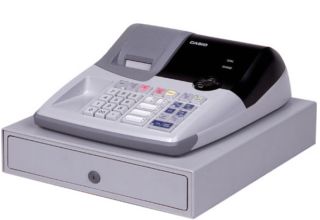1- Turn the register to the appropriate mode or setting for accepting cash sales.
2- Enter the number that you have been assigned as an employee, also called a "clerk code." This code allows the owner to see who processed what cash transactions and how much he is responsible for in the drawer.
3- Enter in the price of the first item you are ringing up, using the numeric keypad. Some electronic cash registers also allow you to enter a "department code" or "item number" so that you know what item was sold. Press "enter" (or if there is a department or item code that you need to enter you will most likely need to press the appropriate department or item key again for the system to accept the price). Continue the same process for each item.

4- When finished, press "Subtotal" to get the final amount of the sale including tax. (You can always press the "Subtotal" key at anytime during the transaction, if the customer wants to see the amount that is currently due before proceeding).
5- Type in the amount of cash received from the customer. Then press the "Change" or "Cash" button. The electronic register should open to allow you to give your customer change. The receipt will print for the customer.
Tips & Warnings
If you are the store owner, be sure that the correct sales tax rate for your municipality is programmed into the electronic cash register along with the clerk codes for your employees. See the instructions for your specific register model. Make certain there is plenty of cash in the form of paper money as well as coins in your cash register before accepting customers. Keep a list of the department or item codes that are programmed into the register nearby for easy reference. You will need these codes to process returns as well as sales.
While you want plenty of change in the cash register, don't ever keep large bills in the cash register for long periods of time. Deposit your larger bills into a bank account as soon as possible.
2- Enter the number that you have been assigned as an employee, also called a "clerk code." This code allows the owner to see who processed what cash transactions and how much he is responsible for in the drawer.
3- Enter in the price of the first item you are ringing up, using the numeric keypad. Some electronic cash registers also allow you to enter a "department code" or "item number" so that you know what item was sold. Press "enter" (or if there is a department or item code that you need to enter you will most likely need to press the appropriate department or item key again for the system to accept the price). Continue the same process for each item.

5- Type in the amount of cash received from the customer. Then press the "Change" or "Cash" button. The electronic register should open to allow you to give your customer change. The receipt will print for the customer.
Tips & Warnings
If you are the store owner, be sure that the correct sales tax rate for your municipality is programmed into the electronic cash register along with the clerk codes for your employees. See the instructions for your specific register model. Make certain there is plenty of cash in the form of paper money as well as coins in your cash register before accepting customers. Keep a list of the department or item codes that are programmed into the register nearby for easy reference. You will need these codes to process returns as well as sales.
While you want plenty of change in the cash register, don't ever keep large bills in the cash register for long periods of time. Deposit your larger bills into a bank account as soon as possible.
How to Run an Electronic Cash Register
4/
5
Oleh
samy






